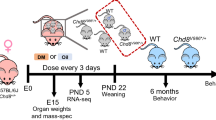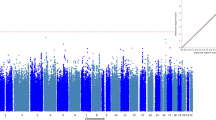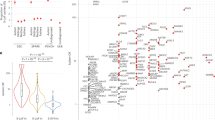Abstract
Organophosphates (OPs) are routinely used as pesticides in agriculture and as insecticides within the household. Our prior work on Reelin and APOE delineated a gene–environment interactive model of autism pathogenesis, whereby genetically vulnerable individuals prenatally exposed to OPs during critical periods in neurodevelopment could undergo altered neuronal migration, resulting in an autistic syndrome. Since household use of OPs is far greater in the USA than in Italy, this model was predicted to hold validity in North America, but not in Europe. Here, we indirectly test this hypothesis by assessing linkage/association between autism and variants of the paraoxonase gene (PON1) encoding paraoxonase, the enzyme responsible for OP detoxification. Three functional single nucleotide polymorphisms, PON1 C−108T, L55M, and Q192R, were assessed in 177 Italian and 107 Caucasian-American complete trios with primary autistic probands. As predicted, Caucasian-American and not Italian families display a significant association between autism and PON1 variants less active in vitro on the OP diazinon (R192), according to case–control contrasts (Q192R: χ2=6.33, 1 df, P<0.025), transmission/disequilibrium tests (Q192R: TDT χ2=5.26, 1 df, P<0.025), family-based association tests (Q192R and L55M: FBAT Z=2.291 and 2.435 respectively, P<0.025), and haplotype-based association tests (L55/R192: HBAT Z=2.430, P<0.025). These results are consistent with our model and provide further support for the hypothesis that concurrent genetic vulnerability and environmental OP exposure may possibly contribute to autism pathogenesis in a sizable subgroup of North American individuals.
This is a preview of subscription content, access via your institution
Access options
Subscribe to this journal
Receive 12 print issues and online access
$259.00 per year
only $21.58 per issue
Buy this article
- Purchase on Springer Link
- Instant access to full article PDF
Prices may be subject to local taxes which are calculated during checkout
Similar content being viewed by others
References
American Psychiatric Association. (1994). Diagnostic and Statistical Manual of Mental Disorders, 4th edn. American Psychiatric Association: Washington, DC, 1994.
Folstein SE, Rosen-Sheidley B . Genetics of autism: complex aetiology for a heterogeneous disorder. Nat Rev Genet 2001; 2: 943–955.
Persico AM, D’Agruma L, Zelante L, Militerni R, Bravaccio C, Schneider C et al. Enhanced APOE2 transmission rates in families with autistic probands. Psychiat Genet 2004; 14: 73–82.
Persico AM, D’Agruma L, Maiorano N, Totaro A, Militerni R, Bravaccio C et al. Reelin gene alleles and haplotypes as a factor predisposing to autistic disorder. Mol Psychiatry 2001; 6: 150–159.
Pickles A, Bolton P, MacDonald H, Bailey A, Le Couteur A, Sim CH et al. Latent-class analysis of recurrence risks for complex phenotypes with selection and measurement error: a twin and family history study of autism. Am J Hum Genet 1995; 57: 717–726.
Keller F, Persico AM . The neurobiology of autistic disorder. Mol Neurobiol 2003; 28: 1–22.
Courchesne E . Brainstem, cerebellar and limbic neuroanatomical abnormalities in autism. Curr Opin Neurobiol 1997; 7: 269–278.
Rodier PM, Ingram JL, Tisdale B, Nelson S, Romano J . Embryological origin for autism: developmental anomalies of the cranial nerve motor nuclei. J Comp Neurol 1996; 370: 247–261.
Nelson KB, Grether JK, Croen LA, Dambrosia JM, Dickens BF, Jelliffe LL et al. Neuropeptides and neurotrophins in neonatal blood of children with autism or mental retardation. Ann Neurol 2001; 49: 597–606.
Teitelbaum P, Teitelbaum O, Nye J, Fryman J, Maurer R . Movement analysis in infancy may be useful for early diagnosis of autism. Proc Natl Acad Sci USA 1998; 95: 13982–13987.
Fatemi SH . Reelin glycoprotein: structure, biology and roles in health and disease. Mol Psychiatry 2005; 10: 251–257.
Lugli G, Krueger JM, Davis JM, Persico AM, Keller F, Smalheiser NR . Methodological factors influencing measurement and processing of plasma reelin in humans. BMC Biochem 2003; 4: 9.
Quattrocchi CC, Wannenes F, Persico AM, Ciafrè SA, D’Arcangelo G, Farace MG et al. Reelin is a serine protease of the extracellular matrix. J Biol Chem 2002; 277: 303–309.
Kiely T, Donaldson D, Grube A . Pesticides industry sales and usage: 2000 and 2001 market estimates. US Environmental Protection Agency, Office of Pesticide Programs, Washington, DC, 2004. Available at http://www.epa.gov/oppbead1/pestsales/index.htm.
Pesticides in the Environment Working Group. Monitoring of pesticides in the environment. UK Environment Agency, Bristol, UK, 2000. Available at http://www.environment-agency.gov.uk.
Aprea C, Strambi M, Novelli MT, Lunghini L, Bozzi N . Biologic monitoring of exposure to organophosphorus pesticides in 195 Italian children. Environ Health Perspect 2000; 108: 521–525.
Aprea C, Betta A, Catenacci G, Lotti A, Magnaghi S, Barisano A et al. Reference values of urinary 3,5,6-trichloro-2-pyridinol in the Italian population—validation of analytical method and preliminary results (multicentric study). J AOAC Int 1999; 82: 305–312.
Hill Jr RH, Head SL, Baker S, Gregg M, Shealy DB, Bailey SL et al. Pesticide residues in urine of adults living in the United States: reference range concentrations. Environ Res 1995; 71: 99–108.
Zhang H, Liu X, Zhang C, Mundo E, Macciardi F, Grayson D et al. Confirmation of an association between Reelin gene alleles and autism spectrum disorders. Mol Psychiatry 2002; 7: 1012–1017.
Skaar DA, Shao Y, Haines JL, Stenger JE, Jaworski J, Martin ER et al. Analysis of the RELN gene as a genetic risk factor for autism. Mol Psychiatry 2005; 10: 563–571.
Devlin B, Bennett P, Dawson G, Figlewicz GA, Grigorenko EL, McMahon W et al. Alleles of a Reelin CGG repeat do not convey liability to autism in a sample from the CPEA network. Am J Med Genet (Neuropsychiat Genet) 2004; 126B: 46–50.
Krebs MO, Betancur C, Leroy S, Bourdel MC, Gillberg C, Leboyer M, The Paris Autism Research International Sibpair (PARIS) Study. Absence of association between a polymorphic GGC repeat in the 5′ untranslated region of the reelin gene and autism. Mol Psychiatry 2002; 7: 801–804.
Bonora E, Beyer KS, Lamb JA, Parr JR, Klauck SM, Benner A et al. Analysis of reelin as a candidate gene for autism. Mol Psychiatry 2003; 8: 885–892.
Li J, Nguyen L, Gleason C, Lotspeich L, Spiker D, Risch N et al. Lack of evidence for an association between WNT2 and RELN polymorphisms and autism. Am J Med Genet (Neuropsychiat Genet) 2004; 126B: 51–57.
Fatemi SH, Snow AV, Stary JM, Araghi-Niknam M, Reutiman TJ, Lee S et al. Reelin signaling is impaired in autism. Biol Psychiatry 2005; 57: 777–787.
Humbert R, Adler DA, Disteche CM, Hassett C, Omiecinski CJ, Furlong CE . The molecular basis of the human serum paraoxonase activity polymorphism. Nat Genet 1993; 3: 73–76.
Brophy VH, Jampsa RL, Clendenning JB, McKinstry LA, Jarvik GP, Furlong CE . Effects of 5′ regulatory-region polymorphisms on paraoxonase-gene (PON1) expression. Am J Hum Genet 2001; 68: 1428–1436.
La Du BN, Aviram M, Billecke S, Navab M, Primo-Parmo S, Sorenson RC et al. On the physiological role(s) of the paroxonases. Chem Biol Interact 1999; 119–120: 379–388.
Costa LG, Li WF, Richter RJ, Shih DM, Lusis A, Furlong CE . The role of paraoxonase (PON1) in the detoxification of organophosphates and its human polymorphism. Chem Biol Interact 1999; 119–120: 429–438.
Geschwind DH, Sowinski J, Lord C, Iversen P, Shestack J, Jones P et al. The autism genetic resource exchange: a resource for the study of autism and related neuropsychiatric conditions. Am J Hum Genet 2001; 69: 463–466.
Conciatori M, Stodgell CJ, Hyman SL, O’Bara M, Militerni R, Bravaccio C et al. Morphogenetic effect of the HOXA1 A218G polymorphism on head circumference in patients with autism. Biol Psychiatry 2004; 55: 413–419.
Clendenning JB, Humbert R, Green ED, Wood C, Traver D, Furlong CE . Structural organization of the human PON1 gene. Genomics 1996; 35: 586–589.
O’Donovan MC, Oefner PJ, Roberts SC, Austin J, Hoogendoorn B, Guy C et al. Blind analysis of denaturing high-performance liquid chromatography as a tool for mutation detection. Genomics 1998; 52: 44–49.
Piven J, Tsai G, Nehme E, Coyle JT, Chase GA, Folstein SE . Platelet serotonin, a possible marker for familial autism. J Autism Dev Disord 1991; 21: 51–59.
Reichelt WH, Knivsberg AM, Nodland M, Stensrud M, Reichelt KL . Urinary peptide levels and patterns in autistic children from seven countries, and the effect of dietary intervention after 4 years. Dev Brain Dysfunct 1997; 10: 44–55.
Spielman RS, Ewens WJ . The TDT and other family-based tests for linkage disequilibrium and association. Am J Hum Genet 1996; 59: 983–989.
Knapp M . The transmission/disequilibrium test and parental-genotype reconstruction: the reconstruction-combined transmission/disequilibrium test. Am J Hum Genet 1999; 64: 861–870.
Horvath S, Xu X, Laird NM . The family based association test method: strategies for studying general genotype–phenotype associations. Eur J Hum Genet 2001; 9: 301–306.
Horvath S, Xu X, Lake SL, Silverman EK, Weiss ST, Laird NM . Family-based tests for associating haplotypes with general phenotype data: application to asthma genetics. Genet Epidemiol 2004; 26: 61–69.
Long JC, Williams RC, Urbanek M . An E-M algorithm and testing strategy for multiple-locus haplotypes. Am J Hum Genet 1995; 56: 799–810.
Leviev I, James RW . Promoter polymorphisms of human paraoxonase PON1 gene and serum paraoxonase activities and concentrations. Arterioscler Thromb Vasc Biol 2000; 20: 516–521.
Wheeler JG, Keavney BD, Watkins H, Collins R, Danesh J . Four paraoxonase gene polymorphisms in 11212 cases of coronary heart disease and 12786 controls: meta-analysis of 43 studies. Lancet 2004; 363: 689–695.
Chen J, Kumar M, Chan W, Berkowitz G, Wetmur JG . Increased influence of genetic variation on PON1 activity in neonates. Environ Health Perspect 2003; 111: 1403–1409.
Rodrigo L, Mackness B, Durrington PN, Hernandez A, Mackness MI . Hydrolysis of platelet-activating factor by human serum paraoxonase. Biochem J 2001; 354: 1–7.
Van Gent T, Heijnen CJ, Treffers PD . Autism and the immune system. J Child Psychol Psychiatry 1997; 38: 337–349.
International Molecular Genetic Study of Autism Consortium. Further characterization of the autism susceptibility locus AUTS1 on chromosome 7q. Hum Mol Genet 2001; 10: 973–982.
Landrigan PJ, Claudio L, Markowitz SB, Berkowitz GS, Brenner BL, Romero H et al. Pesticides and inner-city children: exposures, risks, and prevention. Environ Health Perspect 1999; 107 (Suppl 3): 431–437.
Whyett RM, Barr DB . Measurement of organophosphate metabolites in postpartum meconium as a potential biomarker of prenatal exposure: a validation study. Environ Health Prospect 2001; 109: 417–420.
Whyatt RM, Camann DE, Kinney PL, Reyes A, Ramirez J, Dietrich J et al. Residential pesticide use during pregnancy among a cohort of urban minority women. Environ Health Perspect 2002; 110: 507–514.
Whyatt RM, Barr DB, Camann DE, Kinney PL, Barr JR, Andrews HF et al. Contemporary-use pesticides in personal air samples during pregnancy and blood samples at delivery among urban minority mothers and newborns. Environ Health Perspect 2003; 111: 749–756.
Cole TB, Jampsa RL, Walter BJ, Arndt TL, Richter RJ, Shih DM et al. Expression of human paraoxonase (PON1) during development. Pharmacogenetics 2003; 13: 357–364.
Wilson NK, Chuang JC, Lyu C, Menton R, Morgan MK . Aggregate exposures of nine preschool children to persistent organic pollutants at day care and at home. J Expo Anal Environ Epidemiol 2003; 13: 187–202.
Qiao D, Seidler FJ, Tate CA, Cousins MM, Slotkin TA . Fetal chlorpyrifos exposure: adverse effects on brain cell development and cholinergic biomarkers emerge postnatally and continue into adolescence and adulthood. Environ Health Perspect 2003; 111: 536–544.
Ricceri L, Markina N, Valanzano A, Fortuna S, Cometa MF, Meneguz A et al. Developmental exposure to chlorpyrifos alters reactivity to environmental and social cues in adolescent mice. Toxicol Appl Pharmacol 2003; 191: 189–201.
Aldridge JE, Seidler FJ, Meyer A, Thillai I, Slotkin TA . Serotonergic systems targeted by developmental exposure to chlorpyrifos: effects during different critical periods. Environ Health Perspect 2003; 111: 1736–1743.
Dam K, Seidler FJ, Slotkin TA . Developmental neurotoxicity of chlorpyrifos: delayed targeting of DNA synthesis after repeated administration. Dev Brain Res 1998; 108: 39–45.
Richter RJ, Furlong CE . Determination of paraoxonase (PON1) status requires more than genotyping. Pharmacogenetics 1999; 9: 745–753.
Jarvik GP, Rozek LS, Brophy VH, Hatsukami TS, Richter RJ, Schellenberg GD et al. Paraoxonase (PON1) phenotype is a better predictor of vascular disease than is PON1192 or PON155 genotype. Arterioscl Thromb Vasc Biol 2000; 20: 2441–2447.
Alberti A, Pirrone P, Elia M, Waring RH, Romano C . Sulphation deficit in ‘low-functioning’ autistic children: a pilot study. Biol Psychiatry 1999; 46: 420–424.
Hérault J, Petit E, Martineau J, Cherpi C, Perrot A, Barthélémy C et al. Serotonin and autism: biochemical and molecular biology features. Psychiatry Res 1996; 65: 33–43.
Persico AM, Pascucci T, Puglisi-Allegra S, Militerni R, Bravaccio C, Schneider C et al. Serotonin transporter promoter variants do not explain the hyperserotoninemia in autistic children. Mol Psychiatry 2002; 7: 795–800.
Katsui T, Okuda M, Usuda S, Koizumi T . Kinetics of 3H-serotonin uptake by platelets in infantile autism and developmental language disorder (including five pairs of twins). J Autism Dev Disord 1986; 16: 69–76.
Marazziti D, Muratori F, Cesari A, Masala I, Baroni S, Giannaccini G et al. Increased density of the platelet serotonin transporter in autism. Pharmacopsychiatry 2000; 33: 165–168.
Cook Jr EH, Leventhal BL, Freedman DX . Free serotonin in plasma: autistic children and their first-degree relatives. Biol Psychiatry 1988; 24: 488–491.
Aldridge JE, Seidler FJ, Slotkin TA . Developmental exposure to chlorpyrifos elicits sex-selective alterations of serotonergic synaptic function in adulthood: critical periods and regional selectivity for effects on the serotonin transporter, receptor subtypes, and cell signaling. Environ Health Perspect 2004; 112: 148–155.
Sachana M, Flaskos J, Nikolaidis E, Hargreaves A, Alexaki-Tzivanidou E . Inhibition of rat platelet 5-hydroxytryptamine uptake by chlorpyrifos and carbaryl. Pharmacol Toxicol 2001; 89: 195–200.
Li W-F, Li WF, Costa LG, Richter RJ, Hagen T, Shih DM et al. Catalytic efficiency determines the in-vivo efficacy of PON1 for detoxifying organophosphorus compounds. Pharmacogenetics 2000; 10: 767–779.
Acknowledgements
This work was supported by Telethon-Italy (GGP02019), the Fondation Jerome Lejeune (Paris, France), the Cure Autism Now Foundation (Los Angeles, California), and by grants from the Canadian Institutes for Health Research (#43820) and the Ontario Mental Health Foundation to JJAH. Jeanette JA Holden and Xudong Liu are members of the Autism Spectrum Disorders-Canadian-American Research Consortium (ASD-CARC; www.autismresearch.ca). We gratefully acknowledge all the families who participated in this study, Cristina Aprea for helpful comments, Joseph Piven and Thomas H Wassink for contributing DNA samples collected at the University of Iowa School of Medicine, and the resources provided by the AGRE consortium, including Daniel H Geschwind (University of California, Los Angeles), Maya Bucan (University of Pennsylvania, Philadelphia), Ted Brown (NYS Institute for Basic Research in Developmental Disabilities, New York), Joseph Buxbaum (Mt Sinai School of Medicine, New York), T Conrad Gilliam (Columbia Genome Center, New York), David A Greenberg (Mt Sinai Medical Center, New York), David H Ledbetter (Emory University, Atlanta), Stanley F Nelson (UCLA School of Medicine, Los Angeles), Jonathan Pevsner (Kennedy Krieger Institute, Baltimore), Gerard D Schellenberg (University of Washington and Veterans Affairs Medical Center, Seattle), Carol Samango-Sprouse (Children's National Medical Center, Baltimore), and Rudolph E Tanzi (Massachusetts General Hospital, Boston).
Author information
Authors and Affiliations
Corresponding author
Rights and permissions
About this article
Cite this article
D'Amelio, M., Ricci, I., Sacco, R. et al. Paraoxonase gene variants are associated with autism in North America, but not in Italy: possible regional specificity in gene–environment interactions. Mol Psychiatry 10, 1006–1016 (2005). https://doi.org/10.1038/sj.mp.4001714
Received:
Revised:
Accepted:
Published:
Issue Date:
DOI: https://doi.org/10.1038/sj.mp.4001714
Keywords
This article is cited by
-
The susceptibility of humans to neurodegenerative and neurodevelopmental toxicities caused by organophosphorus pesticides
Archives of Toxicology (2023)
-
The Incidence of the XRCC1 rs25487 and PON1 rs662 Polymorphisms in a Population from Central Brazil: Patterns in an Area with a High Level of Agricultural Activity
Biochemical Genetics (2023)
-
Association between pesticide exposure and paraoxonase-1 (PON1) polymorphisms, and neurobehavioural outcomes in children: a systematic review
Systematic Reviews (2020)
-
Male preconception antioxidant supplementation may lower autism risk: a call for studies
Journal of Assisted Reproduction and Genetics (2020)
-
Children’s low-level pesticide exposure and associations with autism and ADHD: a review
Pediatric Research (2019)



